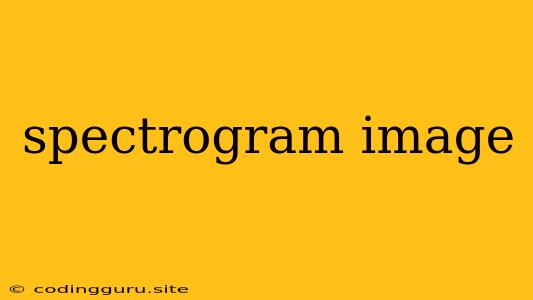What is a Spectrogram Image?
A spectrogram image is a visual representation of the frequency content of a signal over time. It's a powerful tool used in various fields like audio analysis, speech recognition, and medical diagnostics.
Imagine this: You're listening to a piece of music. The music is a complex mixture of different sounds, each with its own unique frequency and intensity. A spectrogram takes this complex signal and breaks it down into its constituent frequencies. It then displays these frequencies over time, creating a visual map of the sound's evolution.
How is a Spectrogram Image Created?
The creation of a spectrogram involves a process called Short-Time Fourier Transform (STFT). This process essentially divides the signal into short segments and then applies a Fourier transform to each segment. The Fourier transform converts the time-domain signal into the frequency domain, giving us the frequency content of each segment.
Think of it like this: The STFT takes a snapshot of the signal at different points in time, analyzes the frequency content of each snapshot, and then puts these snapshots together to form a complete picture.
Interpreting a Spectrogram Image
A spectrogram image typically shows frequency on the vertical axis and time on the horizontal axis. The color or intensity of each point on the spectrogram represents the amplitude or energy of that particular frequency at that particular time.
Here's how to interpret a spectrogram:
- Horizontal axis: Represents time.
- Vertical axis: Represents frequency. Higher frequencies are at the top, lower frequencies at the bottom.
- Color intensity: Represents the amplitude of the sound at that frequency and time. Brighter colors indicate stronger signals.
For example, if you see a bright horizontal band at a specific frequency in the middle of the spectrogram, it indicates a strong signal at that frequency throughout that time segment.
Applications of Spectrogram Images
Spectrograms have a wide range of applications, including:
- Audio analysis: Identifying different instruments, recognizing speech, analyzing music, and detecting audio anomalies.
- Speech recognition: Understanding and processing spoken language.
- Medical diagnostics: Analyzing heartbeats, brain waves, and other physiological signals to diagnose medical conditions.
- Seismic analysis: Detecting and studying earthquakes.
- Machine learning: Training models to recognize patterns in audio data.
- Image processing: Analyzing textures and patterns in images.
Advantages of Using Spectrogram Images
- Visual representation of sound: Spectrograms provide a clear visual representation of the frequency content of a signal, making it easier to analyze complex audio data.
- Time-frequency analysis: They allow us to see how the frequency content of a signal changes over time.
- Pattern recognition: Spectrograms can help us identify patterns and features in audio data that might not be obvious from the raw signal.
Disadvantages of Using Spectrogram Images
- Resolution limitations: The resolution of a spectrogram depends on the window size used in the STFT. A longer window provides better frequency resolution but worse time resolution, and vice versa.
- Interpretation challenges: Interpreting spectrogram images can be challenging, especially for complex signals.
- Computational complexity: Generating a spectrogram requires significant computational resources.
Conclusion
Spectrogram images are powerful tools that allow us to visualize the frequency content of a signal over time. They have a wide range of applications in various fields, from audio analysis to medical diagnostics. Understanding how to create and interpret spectrogram images can help us analyze and understand complex signals and patterns.
